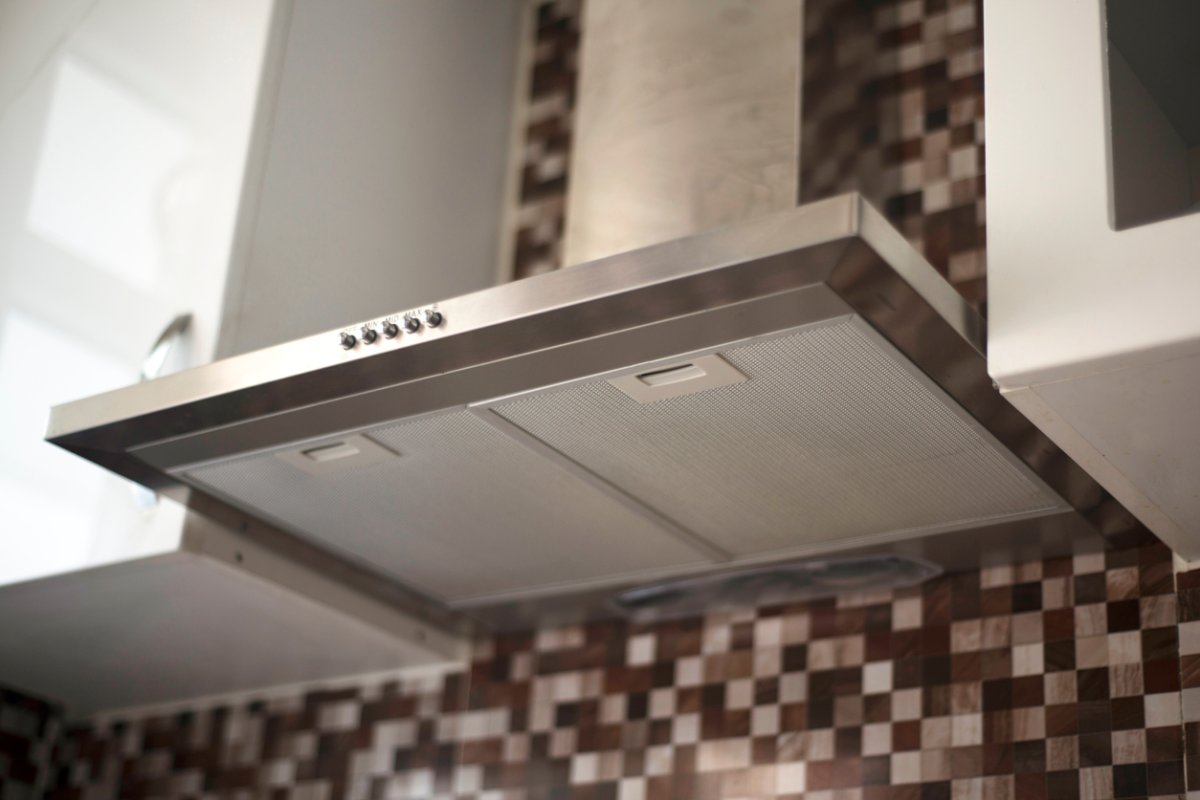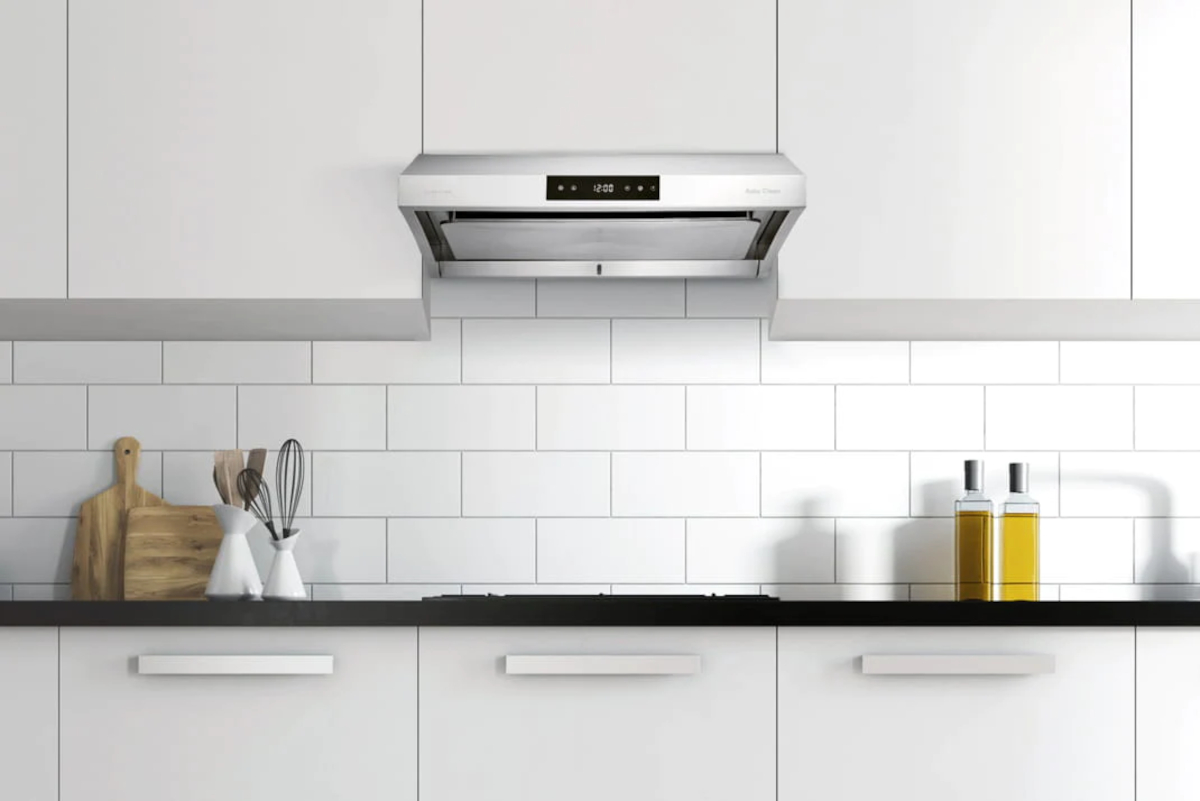

We may earn revenue from the products available on this page and participate in affiliate programs. Learn More ›
Gas stoves’ negative effects on health and indoor air quality has come to the forefront in the U.S., with a Consumer Product Safety Commission investigation of the gas appliance underway and talk of gas stove bans spreading. In fact, New York City, San Francisco, Los Angeles, and Seattle have already enacted legislation concerning natural gas hookups in new homes and buildings.
If you have a gas stove but want to limit its air quality impact on your home, one option is to install a range hood above the stove to improve ventilation in the kitchen. However, you’ll first have to pick between a ducted or ductless range hood. Below are the ducted vs. ductless range hood differences you should know, as well as how to determine which is best for your kitchen and budget.
RELATED: With Talk of Nationwide Bans, Are We Saying Goodbye to the Gas Stove?
What is a range hood?
Range hoods are chimney-like appliances that are often made from stainless steel, giving them an industrial look. They are designed to help keep the air in a kitchen safe and fresh by removing smoke, heat, moisture, fumes, oil, and cooking odors from the room. They do this by using fans to draw the air directly above the stove up into the hood.
Typically mounted above the stove, kitchen hoods either redirect the air to outside the home or recirculate it indoors after it’s filtered. There are ducted, ductless, or convertible kitchen hoods that can function either with or without a duct system leading outside. Range hoods are typically mounted to the wall above the stove in place of cabinetry, underneath upper cabinets, or directly above kitchen island cooktops.

Ducted Range Hood
Ducted range hoods (also called vented range hoods) draw in air from above a kitchen stove and vent it outside via ductwork. In a sense, they operate like a kitchen chimney with an exhaust system. The amount of air that a ducted range hood can pull in and discharge is measured in cubic feet per minute (CFM). The larger the cooking area and the more cooking being done, the higher the CFM should be. Ducted range hoods are usually mounted to the wall with the duct running up and then out through the ceiling or roof.
More effective and efficient than ductless options, ducted range hoods are quieter than ductless range hoods. They also tend to have higher price points and are more challenging to install, since the required ductwork for range hoods adds extra steps to the process.
Our Recommendation: Hauslane Ducted Under Cabinet Range Hood at The Home Depot for $549.99
This sleek and quiet ducted under-cabinet range hood is incredibly powerful, and its automatic steam-cleaning function does not require a water line.

Ductless Range Hood
A ductless range hood (or recirculating range hood) filters and recirculates the air above the stove back into the kitchen, with no ductwork involved. After a fan pulls in polluted air, it’s run through one or more types of filters. The best ductless range hoods use two types of filters to remove grease, smoke, and odors from the air: a carbon charcoal filter that absorbs small particles and a mesh or baffle filter that removes larger particles.
A fan then pushes filtered air back into the room through the range hood vents. While ductless range hoods are affordable and versatile, they do not typically perform as well as ducted hood vents. Like ducted range hoods, ductless models are available in under-cabinet, wall-mounted, and kitchen island configurations.
Our Recommendation: Broan 30-Inch Ductless Under-Cabinet Range Hood at Amazon for $119
This affordable, effective ductless range hood is perfect for installation along an interior wall and features two fan speeds for filtering and recirculating kitchen air.
Ductless range hoods are considered more versatile in terms of installation.
One major advantage of ductless kitchen hoods is that they can be installed without worrying about ductwork that empties to the home exterior, unlike ducted range hoods. This means they can be installed in a wider range of locations in a kitchen.
Additionally, ductless range hoods are easy to mount as a DIY project, taking about an hour to install using a level, drill, and hammer. Installing a ducted system in a kitchen that currently lacks one is more complicated, as it involves cutting holes, laying ductwork, and installing blowers.
Ducted vents do a better job of removing humidity, smoke, and odors.
Although well-maintained ductless range hood filters do a pretty good job of purifying air, they are less effective than ducted hoods with kitchen exhaust fans. Ventless hood filters capture significantly fewer air pollutants and odors, and they do not remove any of the air that originally carried smoke, grease, and odors from the home.
Ducted range hoods, on the other hand, disperse air from above the stove completely outside of the home, resulting in cleaner indoor air quality overall. Ducted hoods are also more efficient at removing humidity and steam from the cooking area, while ductless models can make a kitchen more humid by recirculating the air.

Recirculating range hoods tend to require more maintenance than ducted kitchen exhaust fans.
Because ductless range hood filters need to be cleaned or replaced at least every 6 months, ventless stove hoods require more maintenance than ducted range hoods. Those who cook frequently should wash the exhaust fan filter monthly to prevent grease from clogging it. To do this, slide or pop out the filter; place it in the sink; and scrub it with hot water, baking soda, and a degreasing dish soap. Some ductless range hood filters may even be dishwasher-safe.
It’s important to also check fan parts for wear and tear, clean grease and hard water buildup from the underside of the range hood, and make sure the ductless ventilation system is working properly. Ducted range hoods, meanwhile, can last 10 years or longer with little maintenance besides cleaning the filter as needed.
Typically, ductless stove hoods cost less than their ducted counterparts.
Unvented range hoods are typically more affordable than ducted models, mainly because they are easier to install and do not need to connect to an existing duct system. Ducted range hoods will be even more expensive if ducts need to be installed in the home. Ductless hoods can cost as little as $50 and as much as several hundred dollars, while ducted range hoods start at about $100 and can reach well over $1,000 depending on the model’s specific brand and features.
RELATED: We Spent Months Burning Incense (and Some Dinners) to Find the Best Air Purifiers for Smoke
Consider your space, lifestyle, and budget to determine whether a ducted or ductless range hood is best for you.
When deciding whether to purchase a ducted or ductless range hood, there are a number of key factors to keep in mind.
- Noise: Ducted hoods are usually quieter than ductless models. Some people can tolerate more range hood fan noise than others.
- Appearance: Ductless range hoods tend to be simpler in appearance, so if you’re seeking an attractive and functional kitchen design element, a ducted hood may be the better choice.
- Cooking habits: For people who cook often, a ducted range hood is the best option. They are more powerful, can handle heavy cooking loads, provide improved kitchen ventilation, and last longer than ductless range hoods.
- Versatility: If you have limited kitchen space, no existing duct system in place, a kitchen with no exterior walls, or live in a rental, a ductless range hood may be the better option.
- Humidity: Ducted range hoods more effectively remove humidity from the air than ductless hoods.
- Budget: Ductless range hoods are less expensive and have lower installation fees than ducted models.
The prices listed here are accurate as of publication on 5/30/23.
